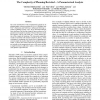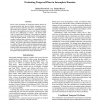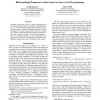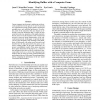AAAI
2012
12 years 1 months ago
2012
The early classifications of the computational complexity of planning under various restrictions in STRIPS (Bylander) and SAS+ (B¨ackstr¨om and Nebel) have influenced followin...
AAAI
2012
12 years 1 months ago
2012
Swirls of ocean currents known as ocean eddies are a crucial component of the ocean’s dynamics. In addition to dominating the ocean’s kinetic energy, eddies play a significan...
AAAI
2012
12 years 1 months ago
2012
Recent work on planning in incomplete domains focuses on constructing plans that succeed despite incomplete knowledge of action preconditions and effects. As planning models becom...
AAAI
2012
12 years 1 months ago
2012
We address the problem of spatial conservation planning in which the goal is to maximize the expected spread of cascades of an endangered species by strategically purchasing land ...
AAAI
2012
12 years 1 months ago
2012
Designing revenue-optimal auctions for various settings is perhaps the most important, yet sometimes most elusive, problem in mechanism design. Spiteful bidders have been intensel...
AAAI
2012
12 years 1 months ago
2012
We present the first real-world benchmark for sequentiallyoptimal team formation, working within the framework of a class of online football prediction games known as Fantasy Foo...
AAAI
2012
12 years 1 months ago
2012
Entity Recognition (ER) is a key component of relation extraction systems and many other natural-language processing applications. Unfortunately, most ER systems are restricted to...
AAAI
2012
12 years 1 months ago
2012
Relation extraction, the process of converting natural language text into structured knowledge, is increasingly important. Most successful techniques use supervised machine learni...
AAAI
2012
12 years 1 months ago
2012
Temporal Action Logics (TAL) is a class of temporal logics for reasoning about actions. We present a reformulation of TAL in Answer Set Programming (ASP), and discuss some synergi...
AAAI
2012
12 years 1 months ago
2012
Current computer involvement in adolescent social networks (youth between the ages of 11 and 17) provides new opportunities to study group dynamics, interactions amongst peers, an...





